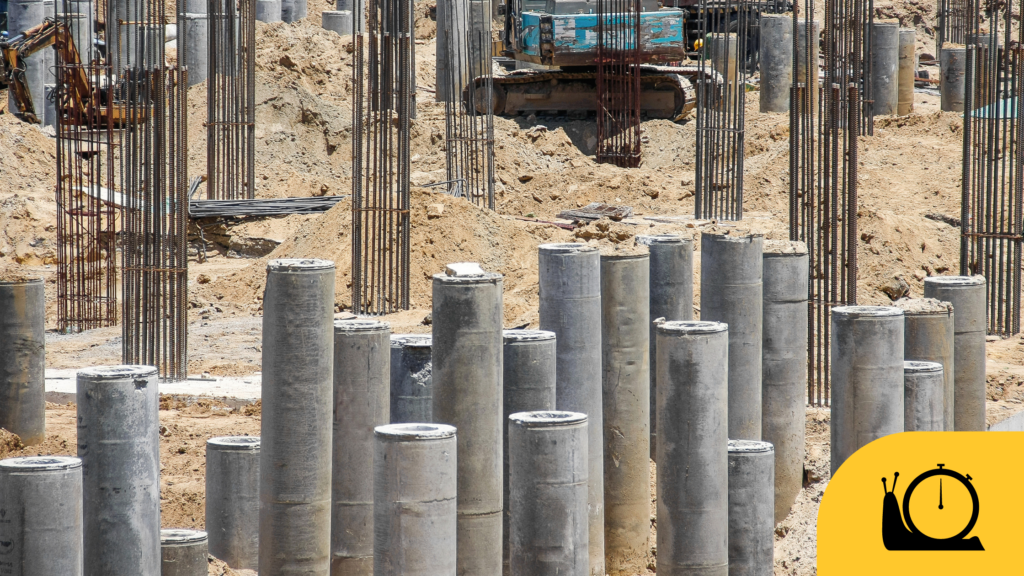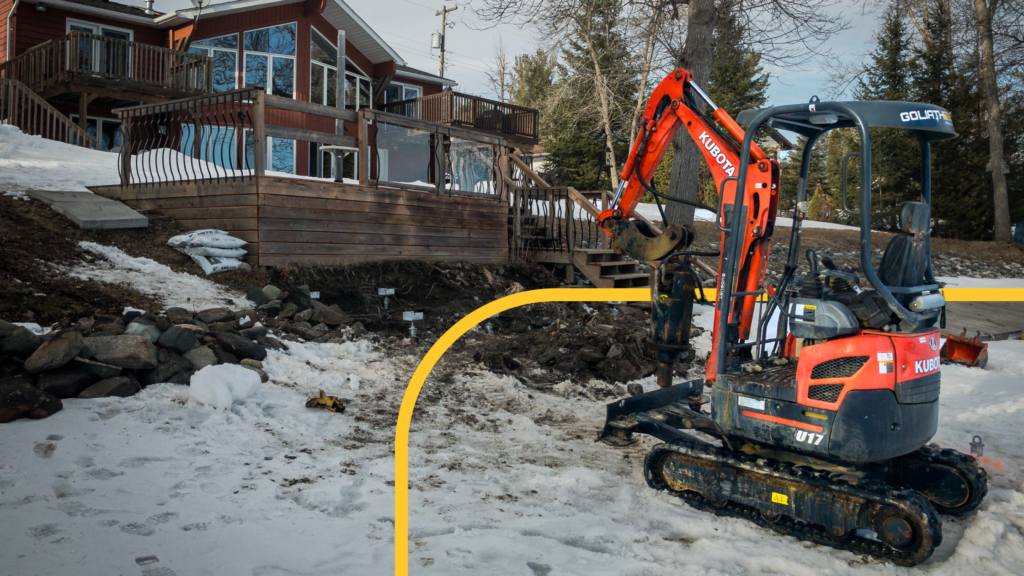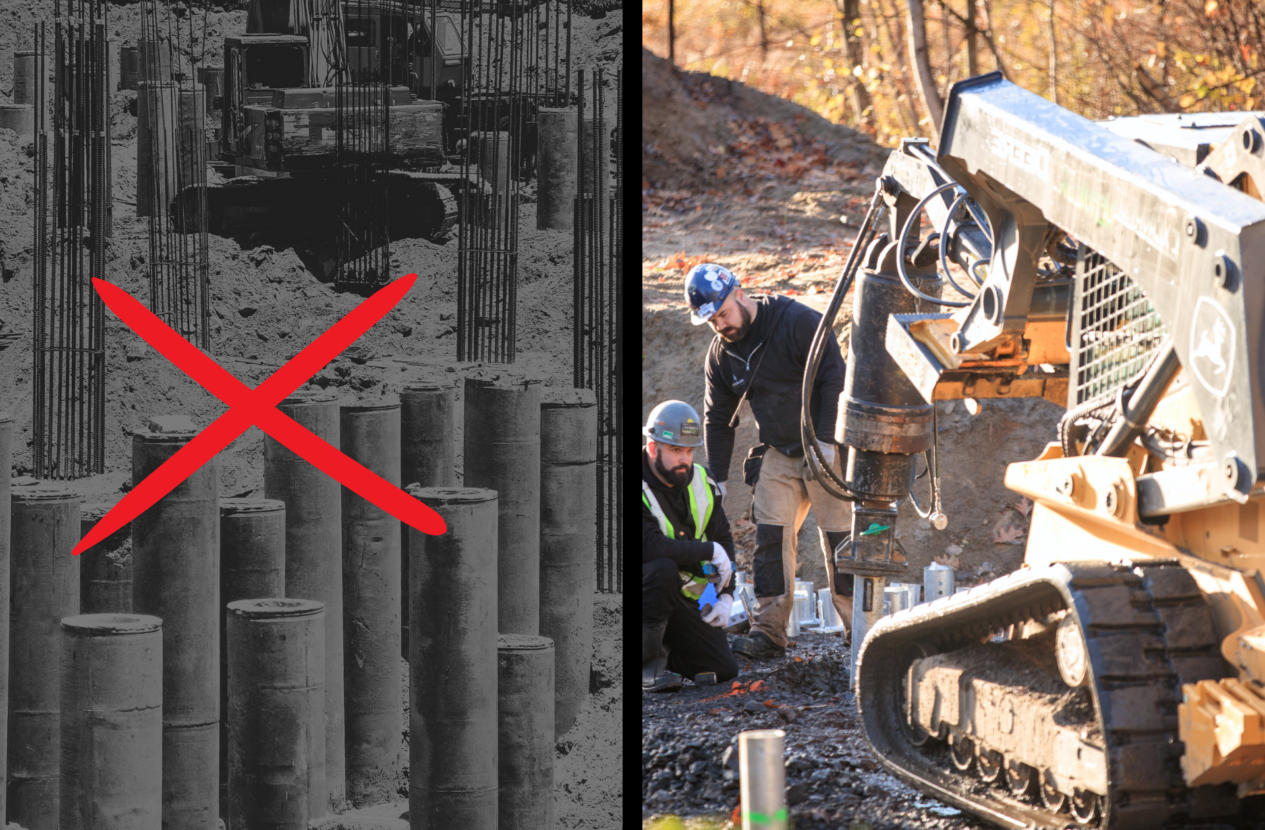Let’s face it, waiting for concrete to dry is about as exciting as watching paint dry, and when you're running a construction business, every minute matters. That’s where screw piles come into play – a faster, more efficient alternative to concrete foundations.
With screw piles, you won’t have time to twiddle your thumbs – before you know it, your foundation system will be good to go.
In this article, we’ll explore the advantages of screw piles over concrete and how they can help construction companies save time and complete projects at record speed.
Topics covered in this article:
- How long does it take for concrete foundations to dry?
- Excavation phase
- Concrete drying process
- Factors influencing concrete drying time
- How screw piles avoid weather-related delays in construction projects
- Advantages of screw piles over concrete foundations

How Long Does Concrete Take to Dry?
When it comes to construction projects, concrete drying time is a crucial consideration. For concrete foundations, this duration can influence the construction timeline and the long-term stability of the structure.
Excavation Phase
Before the concrete is even poured and the drying process begins, the excavation phase must be completed. This phase can be particularly lengthy and complex, especially in areas with a high water table. In such cases, water may fill the holes during excavation, requiring the use of pumps to remove the water. This complication adds extra time and costs to the project.
Concrete Drying Process
Concrete doesn't actually "dry" in the usual sense of the word. Instead, it undergoes a chemical process called hydration, where water reacts with cement to form a solid and durable material. This process can take several weeks or even months to reach full strength.
In general, concrete foundations reach around 70% of their maximum strength after 7 days. However, to achieve enough strength to support heavy structures, it is often recommended to allow a concrete drying time of at least 21 days. This allows hydration to continue, and the concrete to gain strength.
Clearly, the stages involved in using concrete can be long and tedious, especially when considering the unpredictability of weather and its potential impact on projects. Fortunately, thanks to technological advancements and new construction methods, alternatives such as GoliathTech screw piles are now available and offer a viable solution.
Unlike concrete, screw piles do not require drying time and are not affected by weather conditions, allowing for a quick and efficient installation. This makes screw piles an ideal choice for construction projects that need to meet deadlines, regardless of the weather.
By reducing the impact of weather conditions and potential delays, screw piles can help construction companies complete their projects more efficiently and cost-effectively.
Factors Influencing Concrete Drying Time
Several factors can affect how long concrete takes to dry, including:
- Weather conditions: Temperature, humidity, and ventilation all play a role. For example, higher temperatures accelerate the drying process, while high humidity can slow it down.
- Type of cement used: There are different types of cement, some formulated for rapid curing. For example, quick-setting cement can achieve significant strength in 24 hours, though it may be more expensive.
- Water content: A concrete mix with too much water can weaken the final material and prolong drying time. Proper water-to-cement ratio is crucial to ensure the durability and strength of the concrete.
- Additives: Additives can be used to modify the curing properties of concrete. For example, plasticizers can reduce the amount of water needed without compromising the mix’s workability, while curing accelerators can shorten the hardening time.

How Screw Piles Avoid Weather-Related Delays in Construction Projects
As mentioned earlier, weather conditions play a crucial role in determining the drying time of concrete, with factors such as temperature and humidity.
Screw piles, on the other hand, offer a faster alternative. The installation of screw piles can be completed in just a few hours, regardless of the weather conditions.
The Advantages of Screw Piles Over Concrete Foundations
At GoliathTech, screw piles offer an innovative and high-performance alternative to concrete foundations for various projects such as patios, decks, home extensions, electric vehicle charging stations, and solar panels. Their quick installation and strength make them the ideal solution for these types of constructions.
Additionally, our screw piles can be used in conjunction with concrete to reinforce foundations for homes or pools, providing increased protection against long-term cracking. They are also perfect for stabilizing the existing foundations of homes and buildings with weakened structures, extending their durability and safety.
These modern solutions ensure exceptional strength and durability. Designed to adapt to a variety of soil and climate conditions, our screw piles represent a significant advancement in the foundation industry, meeting the contemporary demands of construction projects.
- Quick installation: Screw piles can be installed and ready for use within a few hours. This efficiency significantly reduces the overall construction timeline and eliminates the waiting periods associated with concrete drying.
- Adaptability: Screw piles can be installed in various soil types and under different weather conditions, offering unmatched flexibility. They are ideal for challenging terrains where concrete may not be a viable solution.
- Durability: Screw piles are designed to withstand the harshest weather conditions, ensuring long-term stability. They are less likely to deteriorate in corrosive environments or under extreme thermal variations.
- Cost reduction: The absence of drying time and reduced labor requirements lead to lower overall construction costs. Additionally, their enhanced durability minimizes long-term maintenance costs.
So, What's the Conclusion?
Today, with a foundation system like screw piles, you can enjoy the best of both worlds: a solid foundation without the endless waiting for concrete to dry.
When starting your next construction project, consider exploring the advantages that screw piles can offer. By doing so, you can ensure that your project stays on schedule and within budget, without the delays and expenses associated with traditional concrete drying.
With their reliability, versatility, and adaptability, screw piles provide a solution that helps construction companies get the job done right.
About GoliathTech
Since 2004, GoliathTech has been the most important manufacturer and installer in the helical (screw) pile industry worldwide. Our patented helical pile foundation system surpasses industry standards and has earned us multiple awards and prizes.
Carried out by certified installers, our quick installation process avoids excavation, which protects your landscape and allows you to begin building as soon as the piles are in the ground. Moreover, you can anchor GoliathTech’s helical pile foundations into any soil or space year-round. Installed deep into the ground, beneath the frost line, they solidly support the structure in even the most extreme conditions. Our technology guarantees that a helical (screw) pile foundation won't move or crack over time.
Integrating both strength and know-how, GoliathTech offers the best anchoring solution to support your residential, industrial, commercial, and municipal projects. Trust the experience and expertise of GoliathTech for your foundation projects. Find a certified GoliathTech installer in your region or become a franchisee.
Share this Article


